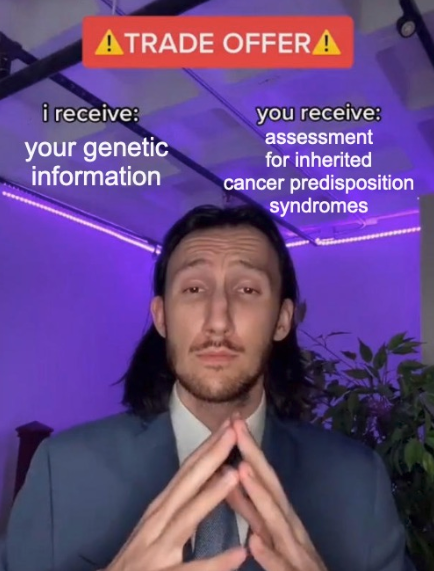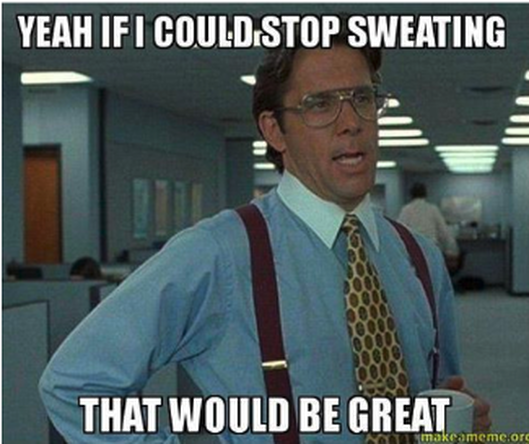Fifty-First issue
January 10th, 2024
Time to offer Merkel some genetic counseling
Merkel cell carcinoma (MCC) is a rare neuroendocrine skin cancer. Early-onset MCC presents in patients younger than 50, constituting only 4% of cases. Researchers wanted to determine the genetic risk factors associated with the development of early-onset MCC. This case-control study included 37 cases of early-onset MCC, 45 cases of later-onset MCC, and 930 controls.
What did they find?
Limitations: It is difficult to determine the exact effect size of genetic variants on the risk of MCC. Genetic testing for later-onset MCC patients was done using whole-exome sequencing rather than genome sequencing.
Main Takeaway: Due to the possible association of early-onset MCC with cancer-predisposing genetic variants, early-onset MCC patients and their families should be considered for genetic testing and counseling. Early-onset MCC should be considered when assessing individuals for inherited cancer predisposition syndromes.
Merkel cell carcinoma (MCC) is a rare neuroendocrine skin cancer. Early-onset MCC presents in patients younger than 50, constituting only 4% of cases. Researchers wanted to determine the genetic risk factors associated with the development of early-onset MCC. This case-control study included 37 cases of early-onset MCC, 45 cases of later-onset MCC, and 930 controls.
What did they find?
- 7 patients with early-onset MCC (19%), 0 patients with later-onset MCC, and 9 control patients (1%) had germline variants in cancer predisposition syndrome genes (ATM, BRCA1, BRCA2, TP53, and MAGT1)
- Compared to controls, early-onset MCC is significantly associated with cancer-predisposing genetic variants (odds ratio, 30.35, 95% CI, 8.89-106.30, p < 0.001)
Limitations: It is difficult to determine the exact effect size of genetic variants on the risk of MCC. Genetic testing for later-onset MCC patients was done using whole-exome sequencing rather than genome sequencing.
Main Takeaway: Due to the possible association of early-onset MCC with cancer-predisposing genetic variants, early-onset MCC patients and their families should be considered for genetic testing and counseling. Early-onset MCC should be considered when assessing individuals for inherited cancer predisposition syndromes.
Surgical excision versus topical 5% 5-fluorouracil and photodynamic therapy for the treatment of Bowen's disease: A multicenter randomized controlled trial
Journal of the American Academy of Dermatology
Journal of the American Academy of Dermatology
Cutting-edge choices: Unveiling the optimal approach for the treatment of pre-cancers
Bowen’s disease, or squamous cell carcinoma in situ (SCCIS), has an incidence of ~15-28 per 100,000 in North America. As Bowen’s disease is non- invasive, treatment is aimed at decreasing the potential risk of progression to invasive SCC.
This randomized, controlled trial (n=250) compared the effectiveness of treatment options for Bowen’s disease by randomly assigning patients to one of the following treatment groups: excision, topical 5% 5-fluorouracil (5-FU), or methylaminolevulinate photodynamic therapy (MAL-PDT).
What did they find?
As this study of noninferiority utilized a margin of 22%, 5-FU was found to be noninferior to excision in sustained lesion clearance at 12 months. However, MAL-PDT noninferiority to excision cannot be concluded. The study further emphasizes that while treatment via excision has the lowest rate of lesion recurrence, the rate of poor cosmetic outcomes and financial cost are considerably higher than noninvasive treatments and must not be overlooked.
Limitations: The follow-up period was limited to 1 year and differences in success rates between treatments may change during additional follow-up.
Main takeaway: As 5-FU is non-inferior to surgical excision and is associated with better cosmetic outcomes and likely lower financial burden, it should be considered over excision in the treatment of Bowen’s disease.
Bowen’s disease, or squamous cell carcinoma in situ (SCCIS), has an incidence of ~15-28 per 100,000 in North America. As Bowen’s disease is non- invasive, treatment is aimed at decreasing the potential risk of progression to invasive SCC.
This randomized, controlled trial (n=250) compared the effectiveness of treatment options for Bowen’s disease by randomly assigning patients to one of the following treatment groups: excision, topical 5% 5-fluorouracil (5-FU), or methylaminolevulinate photodynamic therapy (MAL-PDT).
What did they find?
- The proportion of patients with sustained clearance 1 year post-treatment was 97.4 % after excision, 85.7% after 5-FU, and 82.1% after MAL-PDT
- Absolute differences were -11.7% (95% CI -18.9 to -4.5; P=.0049) for 5-FU versus excision and -15.4% (95% CI - 23.1 to -7.6; P = .00078) for MAL-PDT versus excision
- Noninvasive treatments (5-FU and MAL-PDT) frequently resulted in good or excellent cosmetic outcome as indicated by both the patient and observers (P <.001)
As this study of noninferiority utilized a margin of 22%, 5-FU was found to be noninferior to excision in sustained lesion clearance at 12 months. However, MAL-PDT noninferiority to excision cannot be concluded. The study further emphasizes that while treatment via excision has the lowest rate of lesion recurrence, the rate of poor cosmetic outcomes and financial cost are considerably higher than noninvasive treatments and must not be overlooked.
Limitations: The follow-up period was limited to 1 year and differences in success rates between treatments may change during additional follow-up.
Main takeaway: As 5-FU is non-inferior to surgical excision and is associated with better cosmetic outcomes and likely lower financial burden, it should be considered over excision in the treatment of Bowen’s disease.
Does a biomaterial containing gelatin, manuka honey, and hydroxyapatite aid secondary intention healing of Mohs surgical defects?
Dermatologic Surgery
Dermatologic Surgery
Makes the Mohs(t) of your postop recovery!
There are several advantages to secondary intention healing (SIH) over primary surgical repair, including avoiding risks associated with surgical repair and high patient satisfaction. Biologic dressings used for SIH have lower associated postoperative pain, less frequent dressing changes, and faster healing times compared to surgical closure.
Recently, the FDA approved a novel dressing material that consists of gelatin, manuka honey, and hydroxyapatite. This unblinded, randomized control trial (n=37), evaluated the use of this novel material for wound healing after Mohs Micrographic Surgery (MMS) defects (> 1 cm) on the head or distal lower extremities, assessing time to re-epithelialization, infection rates, pain scores, skin thickness, itching, color, stiffness, and irregularity as end points.
What did they find?
Limitations: Follow-up photos were taken in a non-standardized format.
Main Takeaways: Use of this novel biomaterial may result in favorable outcomes for SIH post-MMS, including reduction in pain and favorable post-procedural skin thickness.
There are several advantages to secondary intention healing (SIH) over primary surgical repair, including avoiding risks associated with surgical repair and high patient satisfaction. Biologic dressings used for SIH have lower associated postoperative pain, less frequent dressing changes, and faster healing times compared to surgical closure.
Recently, the FDA approved a novel dressing material that consists of gelatin, manuka honey, and hydroxyapatite. This unblinded, randomized control trial (n=37), evaluated the use of this novel material for wound healing after Mohs Micrographic Surgery (MMS) defects (> 1 cm) on the head or distal lower extremities, assessing time to re-epithelialization, infection rates, pain scores, skin thickness, itching, color, stiffness, and irregularity as end points.
What did they find?
- There was no significant difference in time to re-epithelialization between control (47.2 days) and the biologic material (75.1 days) (p = .71)
- Differences in itching, color, stiffness, irregularity, and overall assessment were not significant among the two groups
- There was a significant difference in pain score in the control (2.0) and the biomaterial (1.2) (p = .03)
- There was a significant difference in skin thickness in the control (5.0) and the biomaterial (3.33) (p = .03), favoring the biomaterial group
Limitations: Follow-up photos were taken in a non-standardized format.
Main Takeaways: Use of this novel biomaterial may result in favorable outcomes for SIH post-MMS, including reduction in pain and favorable post-procedural skin thickness.
What is the efficacy of microwave therapy on axillary hyperhidrosis?
Journal of Cosmetic Dermatology
Journal of Cosmetic Dermatology
Don’t sweat the small stuff– MiraDry is here to help!
Hyperhidrosis describes excess sweating and maceration of the skin, commonly occurring on palmoplantar and axillary surfaces. Microwave therapy is a novel, non-invasive treatment for axillary hyperhidrosis that targets axillary sweat glands.
This prospective, self-controlled study included patients with primary axillary hyperhidrosis (n=20) who received highest energy MiraDry microwave therapy to the bilateral axillae. Efficacy was evaluated qualitatively using the HDSS and Dermatologic Life Quality Index Scales, and quantitatively evaluating histologic changes of axillary sweat glands at 30 days, 6, 9, and 12 months post-treatment.
What did they find:
Main takeaway: Patients who received MiraDry microwave therapy experienced significant clinical improvement in axillary hyperhidrosis symptoms with a reduction in quantity of sweat glands.
Hyperhidrosis describes excess sweating and maceration of the skin, commonly occurring on palmoplantar and axillary surfaces. Microwave therapy is a novel, non-invasive treatment for axillary hyperhidrosis that targets axillary sweat glands.
This prospective, self-controlled study included patients with primary axillary hyperhidrosis (n=20) who received highest energy MiraDry microwave therapy to the bilateral axillae. Efficacy was evaluated qualitatively using the HDSS and Dermatologic Life Quality Index Scales, and quantitatively evaluating histologic changes of axillary sweat glands at 30 days, 6, 9, and 12 months post-treatment.
What did they find:
- The HDSS score was significantly lower post-treatment (p<0.001), with 90% of subjects (18/20) dropping from level 3 or 4 to below level 1 or 2
- 70% of subjects experienced at least moderate impact on quality of life
- Histopathology and immunohistochemistry showed a significant reduction in quantity of sweat glands 6 months after treatment (p<0.05)
Main takeaway: Patients who received MiraDry microwave therapy experienced significant clinical improvement in axillary hyperhidrosis symptoms with a reduction in quantity of sweat glands.
Immunohistochemical expression of angiotensin-converting enzyme 2 in the skin of patients affected by COVID-19
American Journal of Dermatopathology
American Journal of Dermatopathology
ACE in the cytoplasmic spACE
COVID-19 can have cutaneous manifestations that may present as inflammatory exanthems or vascular lesions. In infected patients, angiotensin-converting enzyme-2 (ACE2) is reduced in host cells and binds to the S-glycoprotein of SARS-CoV-2, allowing viral entry into various cell types. ACE2 is found on keratinocytes, leading to researcher curiosity in ACE2 expression in the skin of patients with COVID-19 pneumonia.
Punch biopsies were collected from COVID-19 pneumonia patients, both with skin manifestations (n=22) and without skin manifestations (n=25). Samples were evaluated for inflammatory changes and cytoplasmic ACE2 expression.
What did they find?
Limitations: This study only included patients from a singular region of Egypt, thus findings may not be generalizable to the world population.
Main Takeaways: COVID-19 patients with skin manifestations may have less severe disease. The presence of ACE2 in the skin may be an indicator of more severe COVID-19 infection.
COVID-19 can have cutaneous manifestations that may present as inflammatory exanthems or vascular lesions. In infected patients, angiotensin-converting enzyme-2 (ACE2) is reduced in host cells and binds to the S-glycoprotein of SARS-CoV-2, allowing viral entry into various cell types. ACE2 is found on keratinocytes, leading to researcher curiosity in ACE2 expression in the skin of patients with COVID-19 pneumonia.
Punch biopsies were collected from COVID-19 pneumonia patients, both with skin manifestations (n=22) and without skin manifestations (n=25). Samples were evaluated for inflammatory changes and cytoplasmic ACE2 expression.
What did they find?
- On histology, patients with skin manifestations showed inflammatory changes more often compared to patients without skin manifestations (p<0.001)
- Most patients without skin manifestations showed positive ACE2 expression (96%) compared to those with skin manifestations (72.7%) (p=0.04)
- Positive ACE2 expression was significantly associated with comorbidities (p=0.032) and higher COVID-19 ABCD triage scores (p=0.033)
- Cases with positive ACE2 expression had significantly higher D-dimer (p=0.015) and respiratory rate (P=0.033), and lower O2 saturation (P=0.030), suggesting that ACE2 expression in skin indicates more severe disease
Limitations: This study only included patients from a singular region of Egypt, thus findings may not be generalizable to the world population.
Main Takeaways: COVID-19 patients with skin manifestations may have less severe disease. The presence of ACE2 in the skin may be an indicator of more severe COVID-19 infection.





